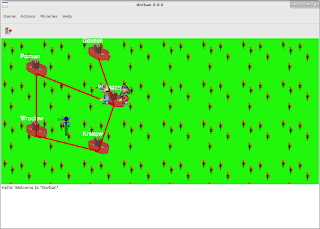A new version of svarog (0.0.4) has been released! It is available at:
https://github.com/pawelbiernacki/svarog
It contains two new commands:
cout << estimate(<depth>,<granularity>) << eol;
and
cout << precalculate(<dept>,<granularity>) << eol;
Both <depth> and <granularity> are integer parameters, <depth> is the depth of the game tree and should be a small integer, <granularity> is the amount of values in one dimension when discretizing the hypercube of beliefs, should also be a small integer, preferably 2.
The file examples/example6_precalculated.svarog has been generated automatically by svarog for the depth 1 and granularity 2. It is not very intelligent (since depth 1 is not much) but svarog is able to use the precalculated knowledge already.
The command "estimate" does not produce a valid Svarog specification - it skips the planning (determining the actions). It can be used to estimate the amount of "on belief" clauses by the "precalculate" command.
WARNING: When using svarog-daemons - they do not benefit of the precalculated knowledge yet.


